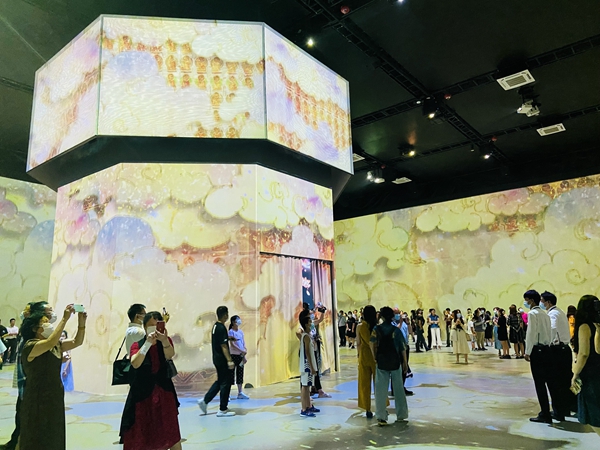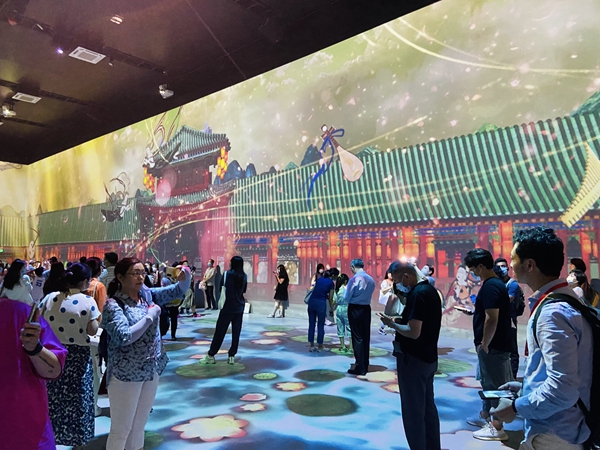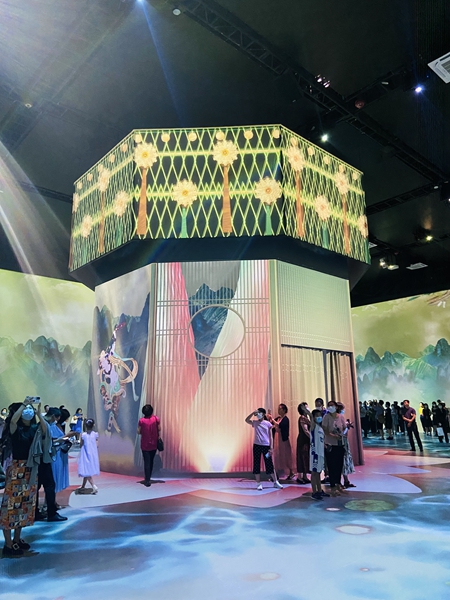Symphony of the senses

An immersive show on Dunhuang is carrying forward the art legacy, Lin Qi reports.
Veteran designer and painter Chang Shana, 90, has used the artistic style of Dunhuang throughout her life, making it a hallmark of her artworks.
Chang first arrived in Dunhuang, in the remoteness of Gansu province, with her father, Chang Shuhong, the founding director of Dunhuang Academy, in the early 1940s.
She grew up watching her father and other members of the academy copying and studying the murals and Buddhist statues in the caves. On school breaks, she joined them in the industrious work to conserve Dunhuang's artistic legacy. She and her father jointly held exhibitions to show their reproductions of the murals from the Mogao and Yulin caves.
Throughout later decades, as a designer and educator in Beijing, Chang Shana continued to incorporate the vibrant patterns she saw in Dunhuang into her creations.
Now she sees her devotion to Dunhuang being celebrated in a very lively way that is suited to the digital age.
Chang Shana's copies of Dunhuang murals, which span different dynasties, have been animated for the production of an immersive art show, titled Meet Dunhuang.
The show, which runs through Oct 18, is being staged in a specially constructed cube that is 18 meters high and covers 1,500 square meters, at Beijing's Huaxi Live Wukesong commercial compound.
A visual and audio feast, it employs the subjects in Chang Shana's remakes and the paintings by Sun Bo and Bao Ying, who also base their work on Dunhuang art. The show also features the images of artifacts at the Hirayama Ikuo Silk Road Museum in Japan.

The production takes the audience back centuries, to the richness and dynamism of Dunhuang as the meeting point of different civilizations along the ancient Silk Road. It offers "a walk through the minds "of devout Buddhist followers and artisans, who invested time and money into creating some of the most enchanting works of art in history.
Chang Shana says she is deeply impressed by such a novel way to enliven and continue the life of Dunhuang art.
"I keep telling people how brilliant Dunhuang is. Art is supposed to convey messages of sincerity, kindness and beauty. I hope when people go looking for pop culture, they will not forget about the roots of our culture.
"Meet Dunhuang is the beginning of a new journey. Dunhuang's art and culture will be carried on with the aid of technology."
The show is staged in two rotations. The first to run through late August includes 12 sections that introduce various art forms as evidence of the exchanges between the East and the West. It features details from a mural that depicts Western Han Dynasty (206 BC-AD 24) envoy Zhang Qian on his exploration of the western regions.

Dancers from Gansu Opera and Dance Theater in Lanzhou, the provincial capital, and Beijing will give joint performances at the site.
In the second rotation, the show will include more motifs, such as the story of the nine-colored deer, a well-known tale recounted in one of Dunhuang's murals.
"I think Meet Dunhuang is a good effort to promote traditional arts and culture without showing real artifacts," says Chen Xuliang, deputy director of Hunan Museum in Changsha, Hunan province, who attended the opening on July 23.
He says people aged between 16 and 35, and accustomed to digital living, account for more than three-quarters of the visitors to the museum.
He says immersive digital art shows have become quite popular in recent years.
"The visual effects will, of course, arrest people's eyes in the first instance, but to make people focus, the production may need more investment in storytelling, like making a film in which elements are integrated to tell a logical story, and history and art are well blended to make a symphony of the senses."

